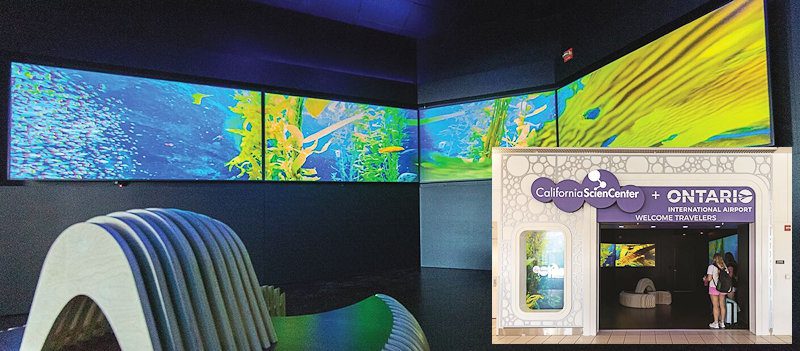As one of six airports vying for passengers in the ultra-competitive Southern California marketplace, Ontario International Airport (ONT) has long realized the need to differentiate itself. Travelers in the Greater Los Angeles area have many other options: Los Angeles International, Long Beach Airport, John Wayne Airport, Hollywood Burbank Airport, and Palm Springs International.
It’s no wonder ONT is constantly looking for ways to zig while neighboring airports zag…and also why it plays video of tranquil underwater scenes on repeat in one of its terminals.

“A couple of years ago, we really wanted to figure out how can we be disruptors in both the region and in the airport world,” explains Elisa Grey, senior vice president of Revenue Management at ONT. “One of the main ways to have that disruptive attitude is to do things differently than what other people in your industry are doing. That really is how one propels their business.”
Blockbuster Change
To educate her predominantly Gen Z staff about disruptors, Grey cites the evolution from Blockbuster Video to Netflix, emphasizing that ONT could be an impactful change agent like Netflix.
“I have had to explain that Blockbuster was where you used to go and rent videos every Friday night,” she laughs, noting that some young employees have no experience with VHS tapes from brick-and-mortar stores. “When Netflix came on, I am sure Blockbuster hated Netflix. We want to be the Netflix of the airport industry.”
Truth be told, Grey doesn’t want ONT to be hated. She does, however, want to delight passengers with revolutionary innovations the same way Netflix wowed the general public by introducing on-demand video streaming.
One step toward that ambitious goal is a tranquil alcove in Terminal 4 that shows digital exhibits from a local museum. The new customer amenity is the result of an official partnership between ONT and the California Science Center, one of the most-visited museums in the United States.
 Monique Hudson, senior vice president of Government Affairs for the Science Center, recalls how it all began: “Ontario Airport came to us wanting an experience for their passengers, something designed to give people refuge,” she explains. “The airport was taking a new approach to use of their space, and we thought it was really good to expand the passenger experience.”
Monique Hudson, senior vice president of Government Affairs for the Science Center, recalls how it all began: “Ontario Airport came to us wanting an experience for their passengers, something designed to give people refuge,” she explains. “The airport was taking a new approach to use of their space, and we thought it was really good to expand the passenger experience.”
Initial meetings in 2022 eventually led to a long-term exhibit area debuting at the airport in summer 2024. The approximately 700-square-foot space features six large video screens that wrap around most of the room. Digital exhibits displayed on the screens will rotate, so even frequent flyers can look forward to seeing something new at the airport.
Paul Watanabe, chief operating officer at the California Science Center, led the team that created the concept design and worked with the installation fabricator. Over the years, the Center had created traveling exhibits that were displayed at other similarly sized museums, but designing the space at ONT was an entirely new mission.
“We had never done anything like this in an airport setting before,” Watanabe says. “The airport space was a totally different concept and challenge for us.”
When conceiving the new space, he knew it had to be small, fully automated and completely turnkey because museum personnel would not be on hand to assist visitors. Typically, the Science Center’s exhibits are highly interactive, but that often requires moving parts that need to be monitored and occasionally repaired.

“We wanted to reduce things that have potential for physical breakage, but still craft an experience,” Watanabe says. The overriding objective was to “inspire and stimulate curiosity,” per the Center’s mission statement.
Dark, Quiet and Peaceful
When designing content for the new space, Watanabe and his staff focused on providing respite to busy travelers.
“We started thinking about what an airport environment really is and we just kind of started throwing out descriptors. Airports are noisy, busy, fast-paced, and can even be a little bit chaotic if you are running late for a flight. So we wanted to intentionally create a very stark contrast,” he explains.
Instead of bright, noisy, and bustling, museum staff opted for dark, quiet and peaceful. The first exhibit, a virtual aquarium, really leans into that design objective. From the comfort of bespoke 360-degree seating, passengers can enjoy the soothing sights and sounds of an underwater kelp forest, like those located off the nearby Pacific coast. But that’s not where video for the exhibit was shot.
Footage was captured by teams of professional divers inside the 188,000-gallon aquarium at the Science Center in downtown Los Angeles. Content created specifically for ONT passengers and visitors features tall strands of kelp, anemones, leopard sharks, moray eels, spiny lobsters and more. Temperatures in the viewing space are kept about 10 degrees cooler than the concourse to make the experience even more immersive.
 facts&figuresProject: Viewing Room for Rotating Digital ExhibitsLocation: Ontario Int’l Airport, in CA Partner: California Science Center Size: 708 sq. ft. Features: 6 large video screens; low lighting; quiet audio; soothing visual content; cool temperatures Buildout Cost: $125,000 Funding: California Science Center Design & Fabrication: Penwal Industries Seating: 10 fixed spaces Video Displays: OSSI Custom Technology Solution Inaugural Exhibit: Kelp Forest Virtual Aquarium Debut: June 2024 Key Benefits: Calming respite area for passengers; more foot traffic from non-ticketed visitors; slight increase in dwell time & concessions revenue |
Watanabe explains that the kelp forest exhibit is designed to be more engaging than didactic. “We are trying to pique viewers’ curiosity and encourage them to seek out knowledge on their own,” he explains, adding that a strong emotional response is highly correlated with memory retention. “When you create a high degree of interest and engagement, it is going to trigger somebody to find out more about [what they are viewing]. We want to elicit that emotional response—like an appetizer, or a teaser. Then hopefully that is enough of a hook to get them interested either to seek out more information about the subject matter or just about the Science Center in general.”
Costs & Benefits of Engagement
Watanabe estimates the Science Center spent about $125,000 building out its small satellite space at ONT.
“That doesn’t encapsulate any of the design work that our own staff put into it or shooting footage in the tank,” he adds. “We knew this was a great opportunity to create a partnership and to get our name a little bit further out from our primary metro market. We decided this is worth our time and we put our own people on it to bring it to fruition.”
In addition, Watanabe applauds ONT for dedicating valuable high-traffic space in one of its terminals to a non-commercial venture. “Instead of chasing a little bit more money out of a lease and revenue agreement, Ontario is dedicating some space to something experiential, and I think this is pretty conceptually unique within the industry,” he says. “I have seen a number of things that Ontario has done to differentiate themselves, but nothing quite like this, where they really took a space and dedicated it to a totally different purpose where the goal wasn’t to drive revenue.”
Speaking from ONT’s perspective, Grey says the new Science Center area dovetails with the disruptor mindset the airport has had for the past couple years. And although revenue is not the focus, it has come into play. “There is a statistic that says for every 1% of happiness created for your passengers, there is a direct 1% increase in potential revenue,” she explains. “And we have actually seen that.”
Grey reports that passenger dwell time in Terminal 4 increased slightly after the new exhibit space opened last spring. There has also been a notable surge in usage of ONT+, a program that allows non-ticketed visitors to enjoy the airport’s post-security amenities. Specifically, the number of gate passes issued in Terminal 4 jumped from 950 in May 2024 to 1,300 in June 2024 (the first full month of operation for the new exhibit space) and 1,500 in July 2024.
Logically, increased dwell time and more non-ticketed visitors create additional sales opportunities for concessionaires. This prompted ONT to diversify the type of amenities located along its main passenger corridors, which then led to an increase in concessions revenue, Grey explains.
“People are coming in early and they are going to concession spaces before going into the California Science Center and relaxing in a really calming environment,” she says.
Helping visitors relax seems to be the primary focus for the airport. In fact, the space’s low lights and soothing sights and sounds make it a de facto sensory room for some patrons. “We actually see passengers take a break there from just the hustle and bustle of getting through the terminal and getting past security,” Grey notes.
While the airport certainly enjoys how passengers and visitors are responding to its new amenity, the desire to be a disruptor is still strong. “We are actually already working on what the next exhibit is going to be,” she says.
So stay tuned. It’s sure to be another blockbuster…or should we say Netflix?



